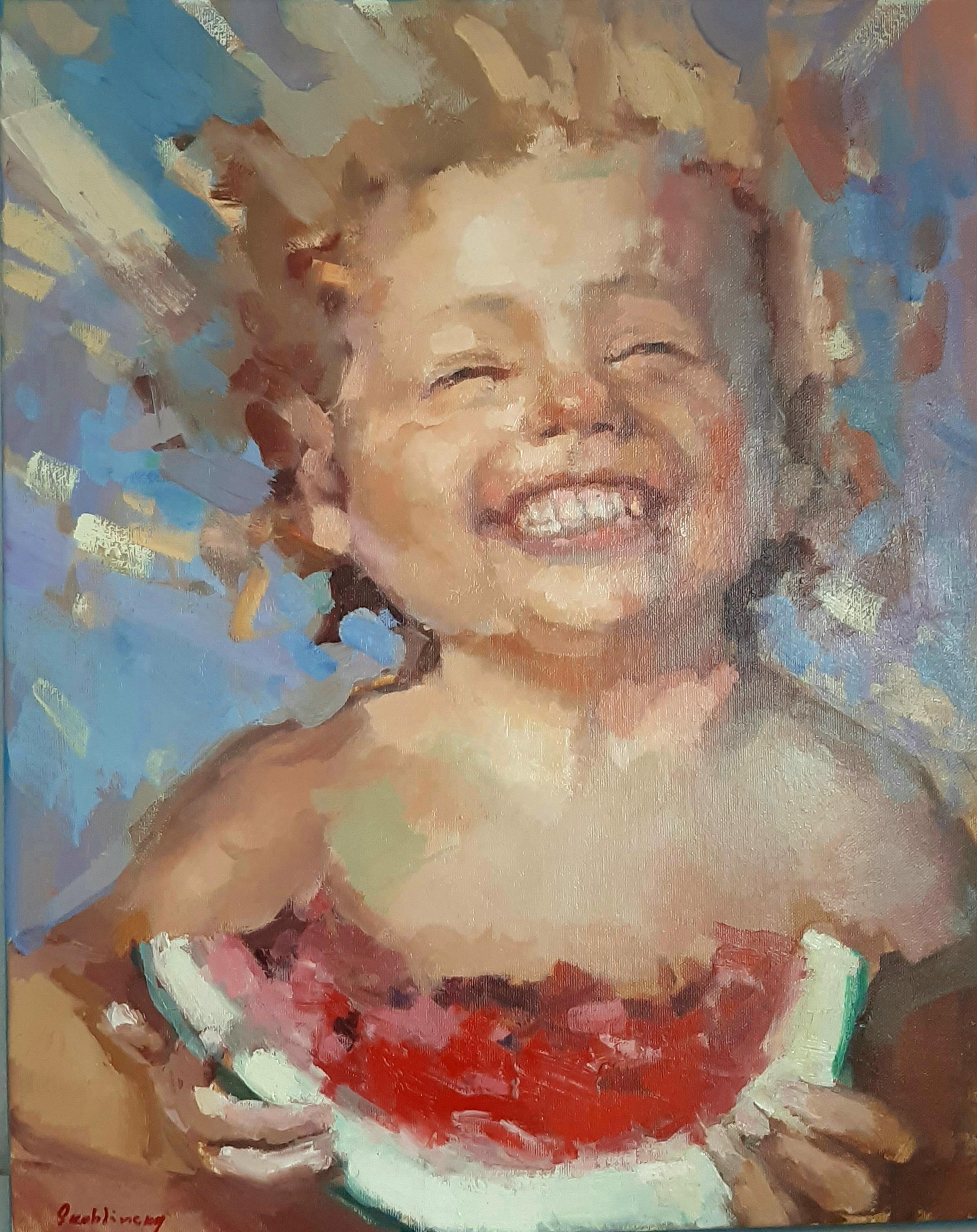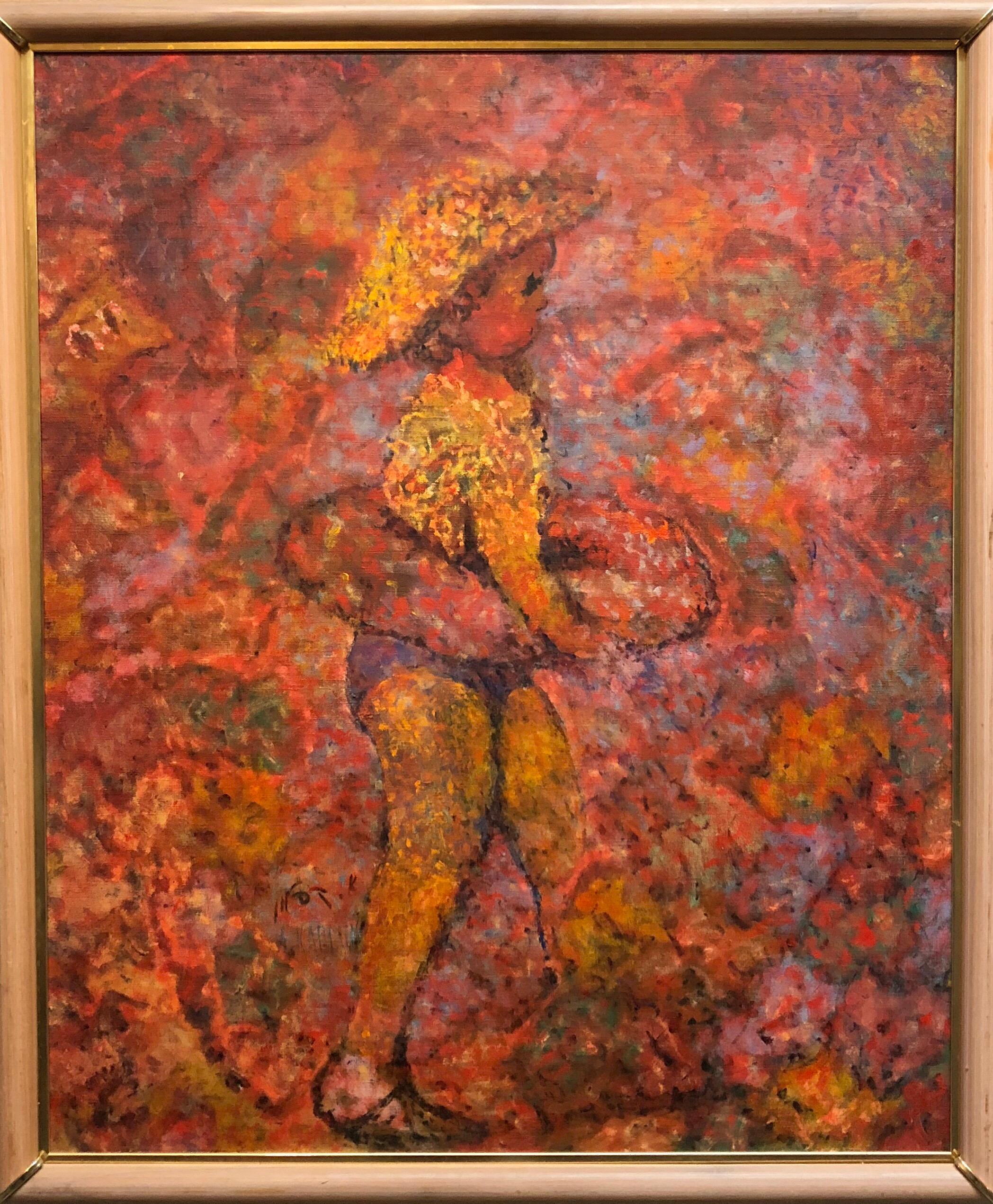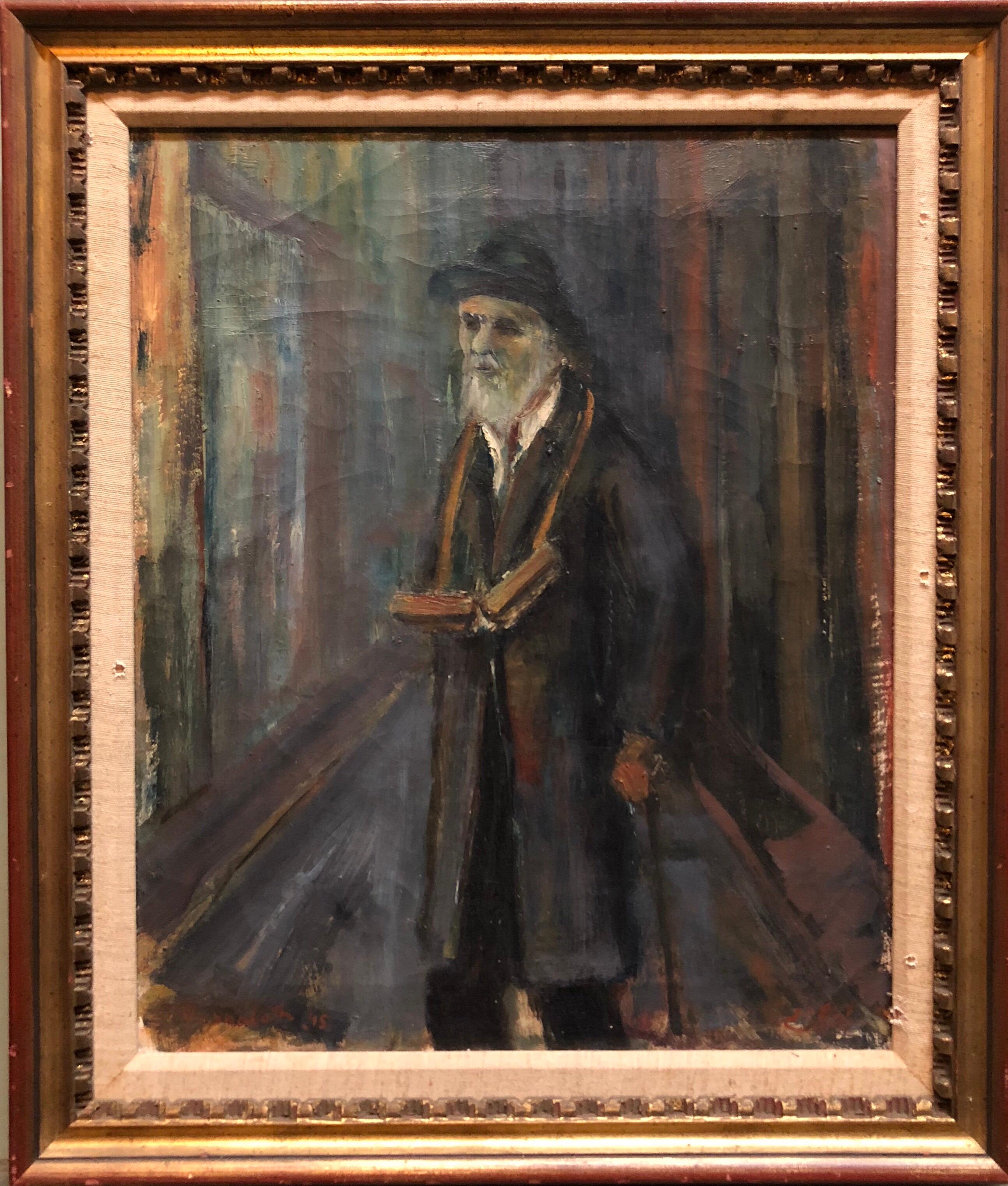Hughes Claude PissarroNeige au Manoir de Miettes (Le Parapluie Bleu) by H. Claude Pissarro - Painting
About the Item
- Creator:Hughes Claude Pissarro (French)
- Dimensions:Height: 19.69 in (50 cm)Width: 24.02 in (61 cm)
- Medium:
- Movement & Style:
- Period:
- Condition:
- Gallery Location:London, GB
- Reference Number:1stDibs: LU261211052512
Hughes Claude Pissarro
Hugues Claude Pissarro, also known professionally as H. Claude Pissarro, is the grandson of the Impressionist painter Camille Pissarro and son of Paulémile Pissarro. Born in Neuilly-sur-Seine and enveloped in an artistic environment, he inevitably spent his childhood and youth with brushes in hand. Carrying on the family tradition established by Camille Pissarro, H. Claude’s father frequently took his son on painting excursions, often accompanied by his numerous artistic friends which proved formative for him.
Initially taught by his father, H. Claude first exhibited his work at the age of fourteen. He subsequently studied art in Paris at prestigious establishments, in particular the École Normale Supérieure, a unique French institution dedicated to the pursuit of achievement and excellence to which only the academic elite have access. He also studied art restoration under Henri Linard, head of the laboratory at the Musée du Louvre. It was inevitable that this educational background would lead him to become a professor of art for much of his professional life and in 1963 he accepted an official invitation to teach art in Monaco.
Throughout his teaching career he remained a prolific artist, exhibiting on several occasions in Paris and London. As with many of his family predecessors, the scope of his work and talent is wide-ranging: from engraver, lithographer, publisher and landscape painter to portraitist. He was even commissioned in 1959 to paint a portrait of President Eisenhower.
H. Claude’s work has evolved through a variety of different styles and techniques, including abstract, avant-garde, minimalist and conceptual art. However, he is now perhaps best known for his Post-Impressionist–style works, which have been exhibited throughout the world since 1985.
Find a collection of authentic Hugues Claude Pissarro paintings and other art on 1stDibs.
(Biography provided by Stern Pissarro Gallery)
- ShippingRetrieving quote...Ships From: London, United Kingdom
- Return PolicyA return for this item may be initiated within 7 days of delivery.
- Nu Assise by Ludovic-Rodo Pissarro - Nude paintingBy Ludovic-Rodo PissarroLocated in London, GBNu Assise by Ludovic-Rodo Pissarro (1878-1952) Oil on canvas 55 x 47 cm (21 ⅝ x 18 ½ inches) Signed lower left, Ludovic Rodo Executed circa 1910 This work is accompanied by a cer...Category
1910s Fauvist Nude Paintings
MaterialsCanvas, Oil
- La Plage d'Houlgate en Auge (Normandie) by H. Claude Pissarro - Oil paintingLocated in London, GB*UK BUYERS WILL PAY AN ADDITIONAL 20% VAT ON TOP OF THE ABOVE PRICE La Plage d'Houlgate en Auge (Normandie) by H. Claude Pissarro (b. 1935) Oil on canvas 46 x 55 cm (18 ⅛ x 21 ⅝ inc...Category
21st Century and Contemporary Post-Impressionist Figurative Paintings
MaterialsCanvas, Oil
- Les Bateaux Lavoir, Paris by Georges Manzana Pissarro - River sceneBy Georges Henri Manzana PissarroLocated in London, GB*UK BUYERS WILL PAY AN ADDITIONAL 5% IMPORT DUTY ON TOP OF THE ABOVE PRICE Les Bateaux Lavoir, Paris by Georges Manzana Pissarro (1871-1961) Oil on canvas 38 x 46 cm (15 x 18 ¹/₈ in...Category
Early 1900s Post-Impressionist Figurative Paintings
MaterialsCanvas, Oil
- L'Île aux Oiseaux by Paulémile Pissarro - Landscape oil paintingBy Paul Emile PissarroLocated in London, GB*UK BUYERS WILL PAY AN ADDITIONAL 20% VAT ON TOP OF THE ABOVE PRICE L'Île aux Oiseaux by Paulémile Pissarro (1884-1972) Oil on canvas 61 x 47.6 cm (24 x ...Category
1930s Post-Impressionist Figurative Paintings
MaterialsCanvas, Oil
- Figurative oil painting titled Femme Mettant Son Bas by Georges Manzana PissarroBy Georges Henri Manzana PissarroLocated in London, GBFemme Mettant Son Bas by Georges Manzana Pissarro (1871 - 1961) Oil on canvas 100 x 56 cm (39 ⅜ x 22 inches) Signed and dated lower left, G. Manzana 1905 This work is accompanied by...Category
Early 1900s Post-Impressionist Figurative Paintings
MaterialsCanvas, Oil
- Beau Temps à Clécy by H. Claude Pissarro - Post-Impressionist style paintingBy Hughes Claude PissarroLocated in London, GB*UK BUYERS WILL PAY AN ADDITIONAL 20% VAT ON TOP OF THE ABOVE PRICE Beau Temps à Clécy by H. Claude Pissarro (b. 1935) Oil on canvas 50 x 61 cm (19 ³/₄ x 24 inches) Signed lower rig...Category
21st Century and Contemporary Post-Impressionist Figurative Paintings
MaterialsCanvas, Oil
- Le carnaval du sage by René MagritteBy René MagritteLocated in New Orleans, LARené Magritte 1898-1967 Belgian Le carnaval du sage (The Sage’s Carnival) Signed “Magritte” (lower right); titled and dated "Le carnaval du sage 1947" (en verso) Oil on canvas The enigmatic paintings of René Magritte have become some of the most familiar and celebrated of the Surrealist movement. Among the most influential of the Surrealist painters of the 20th century, Magritte is an artist of international renown, as beloved for his popular appeal as he is for the psychological intensity of his works. The present oil on canvas, entitled Le carnaval du sage, was executed in 1947 at the height of his career, and it is a tour-de-force example of the haunting, mysterious scenes that comprise his oeuvre. Painted in the years following the Second World War, Le carnaval du sage showcases several recurring themes from Magritte’s oeuvre. Chiefly, a juxtaposition between the visible and the hidden is keenly felt. Throughout his career, Magritte explores the psychological obsession with revealing what is hidden, particularly with regard to the human face. In his Le fils de l’homme, he obscures the face of a man in a bowler hat with an apple, while his Les amants (Metropolitan Museum of Art) conceals the faces of two lovers with white sheets. In Le carnaval du sage, Magritte juxtaposes the blatant nudity of his central figure by masking her face, simultaneously revealing and concealing her from the viewer. The work also incorporates two of Magritte’s most common tropes – the glass of water and the baguette. Lending the scene a strange sense of domesticity, they appear infinitely familiar and distinctly out of place, and thus heighten the uncanny effect of Magritte’s composition. In the background hovers a ghost obscured by a sheet, a figure which was of particular fascination to Magritte beginning in 1946. He once wrote to his fellow Surrealist Paul Nougé: "I saw in a dream an answer to the problem of the ghost: the traditional ghost draped...Category
20th Century Post-Impressionist Nude Paintings
MaterialsCanvas, Oil
- Sunshine Bliss: The Aroma of Summer Watermelon. Portrait Oil painting on canvasLocated in Zofingen, AGOil on canvas. "Sunshine Bliss: The Aroma of Summer Watermelon" In this painting, a vivid and joyful spectacle unfolds before us, as if a sunbeam has penetrated directly onto the c...Category
21st Century and Contemporary Post-Impressionist Portrait Paintings
MaterialsCanvas, Paint, Cotton Canvas, Lights, Oil
- Girl with fruit. Market. Year 1958. Signed Sergio Cirno Bissi (1902 - 1987)Located in Firenze, ITGirl with fruit. Market. Year 1958. Signed Sergio Cirno Bissi (Carmignano, 1902 - Florence, 1987). The very colorful and expressive painting is created...Category
1950s Post-Impressionist Portrait Paintings
MaterialsCanvas, Oil
- Israeli KIbbutz Artist Toddler, Swim Tube Pointilist Oil Painting Bezalel SchoolBy Arie KaplunLocated in Surfside, FLBelarusian born Israeli artist. lived in germany studied at the Bezalel School. Bezalel Academy of Arts and Design is Israel's national school of art. Established in 1906 by Jewish...Category
20th Century Pointillist Figurative Paintings
MaterialsCanvas, Oil
- Judaica Oil Painting 1945 Palestine Old Jewish Man Polish Israeli ArtistBy Ozer ShabatLocated in Surfside, FLOzer Shabat 1978-1901 Ozer Shabbat was an Israeli painter, a resident of Haifa. Belonged to the Palestine Expressionist group of the late 1920s and early 1930s. Shabbat was born in Wolbrom, Poland. At the end of the First World War he went to Holland for agricultural training in the framework of the HeChalutz movement, prior to his immigration to Palestine. In 1920 he immigrated to Eretz Israel and joined the Hulda group. Later he joined the Merhavia group and there he began painting. Because of his desire to study drawing, he left the group and moved to Jerusalem. In 1921, he wrote articles in the newspaper "HaSadeh" on the subject of agriculture and Dutch cheese. Ozer Shabath won the first prize in a competition for the design of the Dutch Consulate's Garden in Jerusalem, enabling him to travel to Paris in 1923 to study painting. Until 1925 he studied painting at the Grande Chaumiere Academy in Paris. This year he returned to Eretz Israel and settled in Haifa, where he lived until his death. In 1928 he participated for the first time in an exhibition of Eretz Israel artists at the Tower of David. Since then he has participated in all the general exhibitions of Israeli artists. In 1934, together with painters Menachem Shemi, Avraham Mohar, Zvi Meirovitch and others, he founded the Haifa Artists' Group. In 1935-36 he toured Europe and visited Italy, France and England. During his visit, he maintained contacts with artists from the Jewish school of Paris. He has exhibited in several solo exhibitions, represented Israel in exhibitions in Europe and participated in international exhibitions in New York, Johannesburg and Zurich. In 1958 he represented Israel in the Venice Biennale. In 1960, Shabat, together with Elchanan Halpern he represented the Israeli Painters Association at the International Congress of Plastic Arts held in Vienna, Austria . In the 40s and 50s he focused on landscape pictures. However, despite the focus on the Israeli landscape, the approach is universal in the framework of the post-Impressionist painting school. In the 1960s, his approach changed and he turned more to abstraction. The abstract direction gradually evolved. The point of departure of the abstract approach is the architectural landscape, but this view loses its real character and becomes only imaginary: the buildings lose their real character and turn into exclusive geometric areas that are usually set against a dark background. Over time, architecture captured the lion's share of his paintings. Cities like Safed, Jaffa and Jerusalem are the subject of many pictures. He taught painting and art at the schools of the kibbutzim in Ramat Yochanan and Kfar Yehoshua, in high schools in Haifa and in the IDF and Gordon seminars. His paintings were purchased and are in the permanent collection of the Bezalel National Museum (now the Israel Museum), Haifa Museum of Art, Haifa Maritime Museum, Acre Municipal Museum. Select Solo exhibitions 1936 - Nadler Gallery, Haifa. 1943 - The Tel Aviv Museum of Art. 1952 - Artists House, Haifa. 1953 - Bezalel House, Jerusalem. 1955 - Gallery in Geneva, Switzerland. 1955 - The Writers' Club, Haifa. 1959 - Artists House, Haifa. 1960 - Museum of Modern Art, Haifa. 1962 - Museum of Modern Art, Haifa. 1963 - Gallery 220, Tel Aviv. 1968 - The Municipal Museum of Beit Emanuel, Ramat Gan. 1979 - Memorial exhibition marking the first anniversary...Category
1940s Post-Impressionist Figurative Paintings
MaterialsCanvas, Oil
- Large French Oil Painting Paris, Seine River w Bridge, Landscape, Lucien DelarueBy Lucien DelarueLocated in Surfside, FLLucien Delarue (1925-2011) Paris Seine River Scene. "Seine at Paris" Provenance: Newman Gallery, Phila. Label verso. Hand signed on Canvas. Dimensions: H: 25 inches: W: 31.5 inches: Frame: 35 X 41 inches Artist Lucien Delarue was born in Paris in 1925, and he is known for his spectacular cityscape painting. Post Impressionist painter He studied at the studios of Grande Chaumiere, Paris and was a pupil of Maitre Yves Brayer. He is best know as a French Impressionist. He loved to paint the romantic streets of Paris with its stunning architecture and beauty. Also included in his repertoire is colorful French floral still life paintings, South of France country cottages, harbor views, and river scenes. At a very early age Delarue began taking part in exhibitions. Quickly he was talking medals for his works including first prize and the Vermeil-Medaille at the Salon Violet. Other gold medals include the Salon of Vincennes, and the Salon of Clichy (1973). In 1974 he won the silver medal at the Salon des Artistes Francais, and a bronze medal at the "Arts-Sciences-Lettres" exhibition in Paris. He also exhibited works at the Museum of Ile de France in the chateau of Sceaux. He held exhibitions in New York and in San Francisco in the United States. He was a member of the Salon des Artistes Francais and of the French Watercolor Society.Lucien Delarue excelled in recreating the cottages, harbor views, and expressionist architecture of Paris in his artwork. His watercolor paintings include color-rich representations of France's many scenic rivers. Delarue would eventually become a member of the French Watercolor Society and the Salon des Artistes Francais. He showed with Henk Bos...Category
Mid-20th Century Post-Impressionist Landscape Paintings
MaterialsCanvas, Oil






